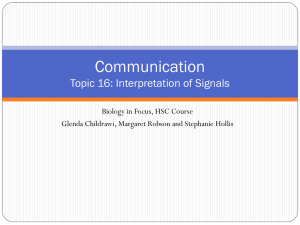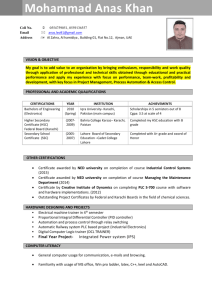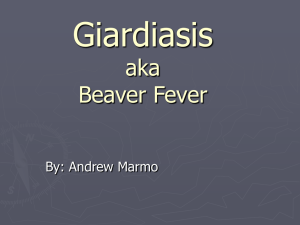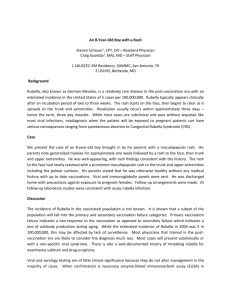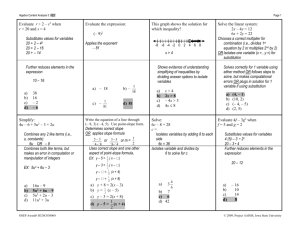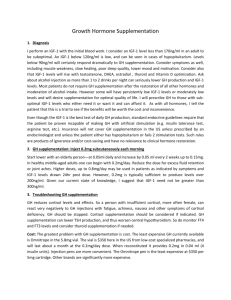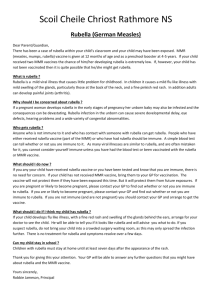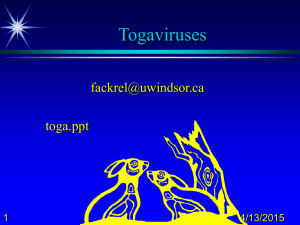Vol. 1 - Baqai Journal Of Health Sciences
advertisement
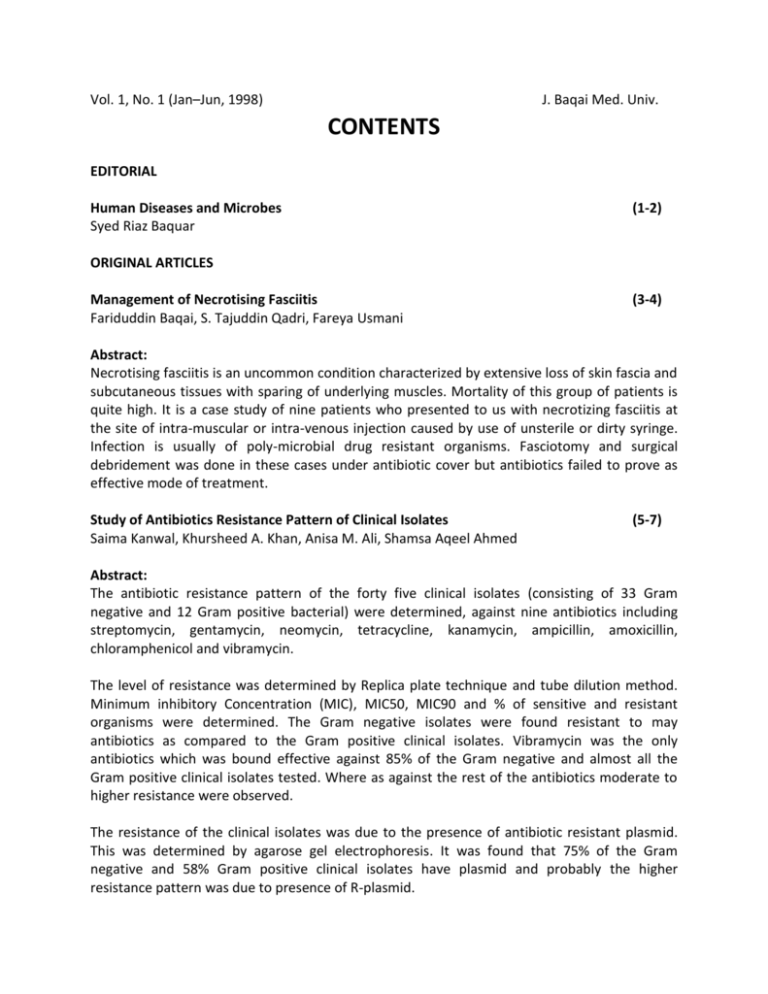
Vol. 1, No. 1 (Jan–Jun, 1998) J. Baqai Med. Univ. CONTENTS EDITORIAL Human Diseases and Microbes Syed Riaz Baquar (1-2) ORIGINAL ARTICLES Management of Necrotising Fasciitis Fariduddin Baqai, S. Tajuddin Qadri, Fareya Usmani (3-4) Abstract: Necrotising fasciitis is an uncommon condition characterized by extensive loss of skin fascia and subcutaneous tissues with sparing of underlying muscles. Mortality of this group of patients is quite high. It is a case study of nine patients who presented to us with necrotizing fasciitis at the site of intra-muscular or intra-venous injection caused by use of unsterile or dirty syringe. Infection is usually of poly-microbial drug resistant organisms. Fasciotomy and surgical debridement was done in these cases under antibiotic cover but antibiotics failed to prove as effective mode of treatment. Study of Antibiotics Resistance Pattern of Clinical Isolates Saima Kanwal, Khursheed A. Khan, Anisa M. Ali, Shamsa Aqeel Ahmed (5-7) Abstract: The antibiotic resistance pattern of the forty five clinical isolates (consisting of 33 Gram negative and 12 Gram positive bacterial) were determined, against nine antibiotics including streptomycin, gentamycin, neomycin, tetracycline, kanamycin, ampicillin, amoxicillin, chloramphenicol and vibramycin. The level of resistance was determined by Replica plate technique and tube dilution method. Minimum inhibitory Concentration (MIC), MIC50, MIC90 and % of sensitive and resistant organisms were determined. The Gram negative isolates were found resistant to may antibiotics as compared to the Gram positive clinical isolates. Vibramycin was the only antibiotics which was bound effective against 85% of the Gram negative and almost all the Gram positive clinical isolates tested. Where as against the rest of the antibiotics moderate to higher resistance were observed. The resistance of the clinical isolates was due to the presence of antibiotic resistant plasmid. This was determined by agarose gel electrophoresis. It was found that 75% of the Gram negative and 58% Gram positive clinical isolates have plasmid and probably the higher resistance pattern was due to presence of R-plasmid. Keywords: Antibiotic Resistance Pattern, Clinical Isolates. Sero-Survey of Rubella in Karachi Hilla R. Dossabhoy, Aqeel Ahmed and Shamsa Aqeel (8-11) Abstract: Rubella or German measles, an exanthematous disease of childhood, has a world-wide distribution. Infection occurs throughout the year with a peak incidence in spring. Epidemics occur every 6-10 years, while pandemics occur every 20-25 years. Infection is transmitted by repiratory route usually by nasal secretions. The virus is of significant importance because of its teratogenic effects on the fetus. The importance of rubella is that women who contract the disease in the first trimester of pregnancy may bear congenitally deformed infants (growth retardation, cardiac anomalies, defects in eye, ear, CNS etc.). A Sero-Survey was conducted in conjunction with a campaign to raise the immunity levels of adolescent & adult women by ELISA. The presence of 1gM antibodies persist throughout lifetime and is an evidence of immunity, as there is only one serotype of rubella virus. In the 15-19 years age grout 81% had protective levels of immunity, 18% showed both 1gM & 1gG levels which indicated that the individuals were exposed to rubella virus either due to infection or due to vaccination. 36% possessed only 1gM, which indicated recent exposure. However 1gG alone was detected in 27% of the total samples, 66% had protective levels of antibodies, 20% possessed both 1gM or 1gG. However, 16% possessed 1gM and 30% 1gG alone. Sero-Survey of Pakistan Women indicates that only 66% of the population has protective levels of antibodies against rubella. The immunity level of the population belonging to lower socioeconomic status is very poor (55%) in contrast to the middle and upper class society (76% and 69% respectively). A high % of vaccinated population were found to have protective levels of antibodies. Low antibody level possessing women were advised to take Rubella vaccine to raise their immune status. Keywords: Sero-Survey, Rubella. How many Malnourished Children are Currently Under Fed? Implication for Nutrition Supplementation in PHC Programmes (12-16) Inayat H. Thaver & Asif Aslam Abstract: One of the most important problems in the world today is that of protein-energy-malnutr4ition (PEM). Though an obvious response to PEM would be food supplementation, the results are not very convincing. To target, through screening, the children needing nutritional supplementation, special measurement ca be used. Thus a) three indicators of nutritional status: weight for age, height for age, and weight for height and b) categorizing each indicator into ‘low,’ ‘normal’ and ‘high’, at least 17 combinations have been generated by WHO for indentifying the need for nutrition supplementation. Date from a squatter settlement of Karachi and slum (Mohall) of Dhaka were used to find out whether currently malnourished children are also currently underfed and need nutrition supplementation? Anthropometric date of 280 children from Karachi and 245 from Dhaka were analyzed. Nutritional status of study children showed that there were fewer (11%) children in ‘low’ weight for height as compared to children in ‘low’ weight for age (39-43%) and height for age (39-58%) indicators, almost 74% of all ‘low’ weight for age children were also ‘low’ in height for age. Only 4-6% of children were labeled as “Currently underfed” (needing nutritional supplementation by using a combination of indicators chart. It is inferred that these primary health care programs do not need a nutrition supplementation program. A health and nutrition education component in these programs is showing promising results. For screening of children for participation in a feeding program it is necessary that estimates of prevalence of malnutrition in a population should also include height, besides weight and age. Keywords: Malnourished Children, Nutrition Supplementation. Residues of Pesticides and their Metabolites in Adipose Tissue samples and Blood Serum Samples of Selected Karachi People Masarat Jahan, S. Naimul Hasan naqvi, M. Arshad Azmi (17-21) Abstract: The experiments were performed to detect the insecticides in human biological material. The adipose tissues were collected from patients during operation at Jinnah Hospital and Baqai Hospital, whereas blood samples were collected from the patients of Aziz Laboratory. Holden and Marsden (1969) and Dale et at. (1970) techniques were adopted for cleaning of adipose tissues samples and blood samples, respectively. All the tested blood and fat samples were fount to have insecticide residues. However, blood samples were found to contain many insecticides than adipose tissue samples. Keywords: Residues, Pesticides, Metabolites, Adipose tissue, blood, Karachi people. Pruritis without Urticaria: An Allergic Manifestation of Giardiasis Iqbal Akhtar Khan and Ghulam Murtaza (22-26) Abstract: Giardiasis is defined as symptomatic or asymptomatic infection by the flagellated parasite Giardia lamblia. Whereas the usual features of this ubiquitous enteric pathogen are related to gastrointestinal system, atypical presentations do occur; among those allergic manifestations deserve special mention. The present study discusses the parasitologically proven cases of Giardiasis with no bowel symptoms and no dermatological problems - the sole complaint being “Pruritis without Urticaria” – refractory to up to 72 hours of antihistamine therapy. Failure to attribute the complaint to any other etiological factor, prompt response within 48 hour to specific antigiardial therapy, complete resolution of the symptoms with that therapy, non recurrence of symptoms within the follow up period of six months provided strong evidence incriminating Giardiasis as the cause of “Pruritis without Urticaria.” The authors emphasize that Giardial infection should be considered in patients with unexplained allergic manifestations even when bowel symptoms are meargre or absent. Keywords: Pruritis without Urticaria, Allergic Manifestation, Giardiasis Fifty Years of Medical Education in Pakistan: Random Thoughts Syed Azhar Ahmed (27-30) Abstract: Pakistan is a young and dynamic nation. All new nations have the potential to turn a new leaf of history. What changes we bring in the education of medical sciences to our youths, in the practice of health delivery and other innovatives, may influence other developing counties. We have started our march towards new goals and new directions. Only time will tell us whether this new trend in community oriented medical education thought in an exclusively medical university is the right choice. Keywords: Medical education. Knowledge of the People Regarding the Causes of Infant Mortality in North Karachi (31-34) Muhammad Irfan Siddiqui Abstract: Literacy rate in Pakistan is only 34% and the knowledge of the people about health problems is even less and that is why every 10th child in Pakistan dies even before his first birthday. The objective of the study was to determine the knowledge of the people about most probable causes of infant mortality. This is a community based study undertaken through sample survey of the population. Two hundred household were visited and only 167 could be interviewed. Respondents were asked to name and prioritize the three more common causes of infant death. Diarrhea was recognized as the most probable cause of infants death by 48%, while 1% recognized respiratory tract infection as the serious disease of infants. A health education programme should be designed and implemented to increase the awareness of community about health problem and their management. There should be more than one approach for the collection of date so that bias could be eliminated and a better picture could be obtained for this type of important variable. Keywords: knowledge, Infant, Mortality, Karachi, Pattern, Pakistan. REVIEW ARTICLES Ocular Parasitic Worm Infections: A Review Fatima M. Bilqees (35-47) Abstract: Parasitic worm infections in the human eye are reviewed and reported here. These include infection by the roundworms (nematodes), tapeworms (cestodes), and the flatworms (trematodes). Most of the eye infection are caused by the larval forms and are transmitted by various animals. Twenty nematode species, six species of cestodes and six species of trematodes are known to infect human eye. Out of these only 2 species of nematodes are the natural parasites of man infecting the eye. While all others are the parasites of animals or infecting the abnormal sites, the eye in human. Keywords: Parasitic worm, ocular infections, review. Genetics of Hemophilia Moinuddin (48-51) Rabies: Black Warrant from Man’s Best Friend Muhammad Ahmad Khan (52-57) Abstract: Rabies, which has a historical perspective, is a very lethal disease with worldwide distribution, the impact being greatest in the tropics. It is transmitted to man via the bite of an infected mammal which is usually a dog, the principal reservoir. The disease is universally incurable once the symptoms have established. The diagnosis is in fact Black Warrant, issued by the man’s Best Friend. However the doomed patient could have been saved if proper post-exposure prophylasis was made available. The immunization regime is simple, sale and reliable. The calamity thus becomes preventable. Dental Considerations in Patients Receiving Radiotherapy for Oral Cancer: A Review of Complications and their Management (58-62) Syed Mahmood Haider Abstract: A review of the complications of radiotherapy effecting the teeth, supporting structures and the tissues of the maxillofacial region is presented. The most common recognised complications are xerostomia, radiation caries, osteoradionecrosis, mucositis, damage to developing teeth, taste loss and radionecrotic ulcers. The management and dental considerations are discussed in detail. CASE REPORTS Abdominal Tuberculosis Presenting with Intestinal Perforation and Peritonitis (63) Fariduddin Baqai, B.U. Zakai, A.K. Qadri, M. Junaid, S. Tajuddin Qadri, and Fareya Usmani Magnetic Resonance Cholangiopancreatogram: A Non-Invasive Tool for Earlier Diagnosis of Carcinoma of Ampula of Vater (64) Fariduddin Baqai, M. Junaid, A.K. Qadri, Fareya Usmani and S.T. Qadri Multiple Loose Bodies in the Knees Shahid Ilyas and Mujahid Humail (65) A Plastic Whistle in the Trachea: A Case Presentation Abdul Qayoom (66-67) Abstract: A case of a foreign body in the Trachea is reported here. A child, eight years old, with a history of whistling sound on exhalation and slight cough, as the early symptoms, was investigated. Obstructive airway symptoms were completely absent. Routine plaint X-ray chest did not show the signs of foreign body impact in respiratory passage. A plastic whistle was removed by laryagoscopy, from the sub glottis region. Keywords: Foreign body – Trachea. NEWS OF MEDICAL INTEREST Spores for Human Bodies World Retina Day Observed Genitically Targetted Weapons A Variant Mad Cow Disease in Human Cardiac-Valve Surgery Transmitted Live Herbal Powder (68-70) INSTRUCTIONS TO AUTHORS (71)
